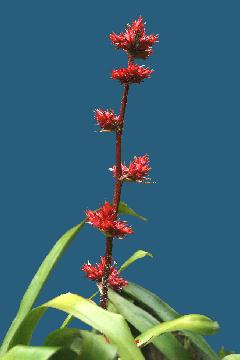
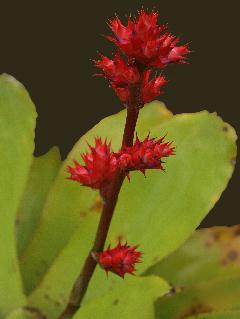
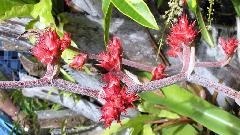
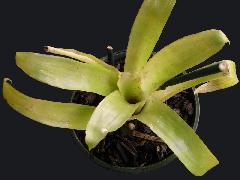
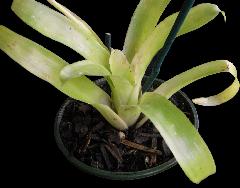
Description from S&D
Plant flowering to 12 dm high.
Leaves many in a densely funnelform rosette, 7-11 dm long;
sheaths large, broadly elliptic, entire, dark castaneous, covered with minute appressed brown scales;
blades ligulate, broadly acute or rounded, apiculate, to 75 mm wide, densely pale-lepidote especially beneath, laxly serrate with spines 3.5 mm long.
Scape erect or in the largest plants sometimes slightly decurved, stout;
scape-bracts erect, densely imbricate, ovate, membranaceous, red or yellow.
Inflorescence tripinnate, dense toward apex, elsewhere lax; axes flocculose at the nodes; primary bracts like the scape-bracts, shorter than the axillary branches; upper branches simple, very short, lower branches to 8 cm long with 2-6 spikes massed at the apex;
spikes sessile, subglobose to cylindric, 3-7 cm long.
Floral bracts spreading, long-attenuate from a suborbicular or broadly ovate base, 2-3 cm long, obscurely denticulate, coriaceous, strongly nerved, nearly glabrous, red or purple in life.
Sepals triangular, acute, 15-18 mm long, carinate, glabrous, the 2 posterior distinctly exceeding the anterior;
petals 2 cm long, bearing 2 long scales, the blades elliptic, acute, purple;
stamens included, anthers acute;
ovary obconic, strongly compressed, glabrous, 5 mm long, epigynous tube lacking; placentae apical; ovules long-caudate.
Type. Martius s n (holotype, M; isotype, B; photo F 18761), Sincora, Bahia, Brazil, 1818.
Distribution. Epiphytic and terrestrial, 80-1400 m alt, Lesser Antilles (doubtful) to Tobago, Trinidad, Venezuela and northeastern Brazil.
WINDWARD ISLANDS: Martinique: Cultivated at Castleton Gardens, Jamaica. "Received from Martinique many years ago." Harris in Bot. Dept. Herb. 11711 (NY). VENEZUELA. Delta Amacuro: Amacuro to mouth of Deadwater Creek, Sierra Imataca, 7 Nov 1960, Steyermark 87385 (US, VEN). Miranda: Parque Nacional de Guatopo, Santa Teresa to Altagracia de Orituco, 28 Nov 1961, Steyermark 90147 (US, VEN). Distrito Federal: Cerro Naiguata, 3 Nov 1963, Steyermark 91888 (US, VEN). Aragua: Parque Nacio¬nal, 14 Sep 1946, H. Pittier 15248 (US, VEN); Oct 1946, 15261 (US, VEN); Oct 1947, 15596 (US, VEN); Rancho Grande, Maracay, 30 Jul 1948, Beebe 189 (US); 14 Oct 1951, Foster 2750 (VEN). Yaracuy: Aracal, San Felipe, 28 Oct 1949, Trujillo & Fernandez 601 (VEN); San Felipe to Aroa, 27 Nov 1952, Aristeguieta & Pennier 1146 (VEN). Falcon: Curimagua to San Luis, 18 Jul 1967, Steyermark 99107 (VEN). Bolivar: El Palmar, Rio La Reforma to Puerto Rico, Sierra Imataca, 7 Dec 1960, Steyermark 87829 (NY); 12 Dec 1960, 87988 (US, VEN), TRINIDAD. Fendler 841 in part (BM); Moruga, Edward Trace, 8 Jun 1916, Broadway 8203 (TRIN); Tabaquite, Mar 1921, Britton, Freeman & Nowell258/ (GH, NY, TRIN); 6 Apr 1955, Aitken s n (US); 3 Dec 1955, Simmonds s n (TRIN); Tamana, Sep 1942, Pittendrigh 1054 (US); 1944, 1050 (US). TOBAGO. Mason Hall, 6 May 1913, Broadway 4517 (F, Z); 6 Apr 1914, Broadway 4834 (US). BRAZIL. Piaui: Guaribas, Luetzelburg s n (! Mez); Parnagua, Luetzelburg s n (! Mez). Alagoas: Marechal Deodoro, Andrade-Lima s n (IPA, US). Bahia: Paramirim dos Creoulos, Luetzelburg (! Mez); Rio Sao Francisco, northeastern Bahia, Luetzelburg s n (! Mez); Salvador, 1939, Foster 41 (GH, R); Agua Preta, 1939, Foster 79 (GH); Milagres to Maracas, 18 Oct 1948, Foster 2453 (US).
Aechmea glomerata Hooker filius, Bot. Mag. 93: pl. 5668. 1867; as to material illustrated, non Pironneava glomerata Gaudichaud.(see Hohenbergia augusta)
Tab. 5668
Aechmea glomerata
Crowded-flowered Aechmea
Nat. Ord. Bromeliaceae – Hexandria Monogynia
Gen. Char. (Vide supra Tab. 5447)
Aechmea glomerata; foliis e basi amplexantibus sensim dilatatis late lineari-v. oblongo-ligulatis cuspidatis 3-4 poll. latis viridibus, margine spinulis remotiusculis brevibus nigris inferioribus crebrioribus recurvis ornato, scapo erecto folio longiore ramoso viridi-roseo picto, ramis brevibus undique floriferis, floribus bracteatis dense glomeratis, bracteis basi ovatis dein subulatis sepalisque erectis imbricatis sanguineis pungentibus, petalis violaceis acuminatis, ungue apice 2-squamato, filamentis filiformibus.
PIRONNEAVA glomerata, Gaud. Voy. Bonite, t. 63.
HOPLOPHYTUM augustum, partim. Beer, Die Familie der Bromeliaceen, p. 136
A native of the province of Bahia, in Brazil, from whence living specimens were sent in 1863 by C. Williams, Esq. of that city, which flowered in the Palm House of the Royal Gardens in March of the present year. It is a most beautiful plant, easy of cultivation, and is very effective at a season when the tropical houses are rather deficient in conspicuous plants.
This species is exceedingly well figured in the ‘Botany of the Voyage of the French Frigate Bonite’, a work which is unfortunately unaccompanied by descriptive matter; it there bears the generic name of Pironneava, which is probably synonymous with Beer’s Hoplophytum, founded on a group of Aechmeas with rigid spinescent foliage, branched inflorescence, an oboid ovary crowned with the subulate calyx-teeth, an almost closed perianth, and erect petals.
Beer, in the above-quoted work, confounds this with the H. augustum (Tillandsia augusta, Arrab. Fl. Flum. t.135), a plant with woolly inflorescence, and much smaller flowers, according to the figure.
DESCR. Quite glabrous. stem simple, or branched at the base only. Leaves spreading on all sides, one to two and a half long, four to six inches broad, linear oblong, rounded at the apex, with a cuspidate point; beset along the margin with short recurved and closer-set, dull green, not glaucous nor shining, nerveless, concave below, not thick in texture. Scape stout, erect, six to eight inches high, bearing a brilliantly coloured blood-red branched panicle, of large bracts studded with small violet flowers; rachis green, tinged with red; floriferous branches short, thick, forming with the dense bracts broadly ovoid masses. Bracts rather longer than the flowers, subsquarrose, ovate, with long subulate pungent apices, Calyx-lobes ovate, acuminate, pungent. Petals twice as long, violet; blade linear-oblong, with recurved acuminate apex, the claw with two scales at the junction with the blade. Filaments filiform; anthers linear. Stigma subclavate, with a twisted apex – J D H
Painting
Fig.1. Flower. 2. Petal and stamens. 3. Ovary, style, and stigma – all magnified
From Baker 1889
51. AE. GLOMERATA Hook. in Bot. Mag. t. 6668.
Hohenbergia stellata Schultes fil. Syst. Veg. vii. 1251
H. erythrostachys Brong. in Journ. Imp. Soc. Hort. July, 1864, with fig.; Carriere in Rev.
Hort. 1869, 217 ,fig, 53 (M.D.)
Pironneava roseo-caerulea K. Koch.
P. Morreniana Regel, Gartenfl. t. 805.
Leaves 12-20 in a utricular rosette, lorate from an ovate base, 11/2 - 2 ft. long, 2-3 in. broad at the middle, moderately horny in texture, plain green on both sides, obscurely mottled with darker green when young, deltoid-cuspidate at the tip, the marginal prickles minute, brown, deltoid. Peduncle 1-1 ½ ft. long; bract-leaves pale, adpressed. Inflorescence a narrow panicle a foot long; clusters of flowers globose, 1-1 1/4 in. diam., the upper close and sessile, the lower remote ancl peduncled; flower-bracts ovate-acuminate, bright red, 1/2-3/4 in. long. Calyx with ovary ½ - 5/8 in. long; sepals deltoid-cuspidate. Petals reddish lilac, twice as long as the sepals.
Var. PALLIDA Baker.
Flower-bracts greenish white and ovary the same colour.
Hab. Brazil, province of Bahia. First gathered by Martius 2211. Introduced into cultivation by M. Porte about 1860, and now one of the commonest species of the genus.
Protologue
52. Aechmea oligosphaera Baker, Handb. Bromel. 48. 1889. Type. Caracas, Venezuela, Gollmer s n (B, F photo 11297), 13 Nov 1853.
Leaves lorate, moderately thin, 2 in. broad, rounded to a cusp at the apex; marginal prickles small, deflexed.
Inflorescence a panicle with shortly peduncled globose heads 2 1/2 -3 in. diam.;
branch-bracts large, ovate-lanceolate;
flower-bracts ovate-acuminate, an inch long.
Sepals lanceolate-acuminate, 1/3 in. long.
Petals not seen.
Hab. Caraces, Gollmcr ! (Herb. Reg. Berol.). Collected in 1853. This no doubt is the Venezuelan plant referred by Dr. Karl Koch to Ae. glomerata.
Protologue
54. Aechmea longisepala Baker, Handb. Bromel. 48. 1889. Type. Bahia, Brazil, Blanchet 241 (BM).
Habit of Ae. glomerata, Leaves not green.
Inflorescence a long panicle, the lower branches formed of 8-10 densely glomerate spikes forming a globose cluster 3-4 in. diam., on a short spreading peduncle.
Flower-bracts ovate-cuspidate, coriaceous, 3/4-1 in. long.
Calyx with ovary 3/4 in. long;
sepals lanceolate-acuminate.
Hab. Bahia, Blanchct 241(Herb. Mus. Brit.).
In Mez 1935
1. H. oligosphaera. (Bak.) Mez in DC. Monogr. Phaner. IX. (1896) 124.
Aechmea oligosphaera Bak. Bromel. (1889) 48.
Ae. glomerata C. Koch (non alior.) ex Bak., l. c. -
Ae. oligosepala Ind. Kew. 1. Suppl. (1906) 12, sphalm.
Folia linearia, apice rotundata impositeque mucronata, spinulis 1-1,5 mm longis bene armata, ad 55 mm lata. Inflorcscentia 2-pinnatim panniculata, e strobilis 30-40 mm longis, subglobosis, glabris, 7-12-floris, ternis vel quaternis dense glomeratis, breviter stipitatis composita; bracteis primariis infimis maximis strobiles longe superantibus; bracteis florigeris purpureis, e fere orbiculari longe acuminatis et in acumen pungens desinentibus, ad 30 mm longis. Flores petalis neglectis ad 22 mm longi; sepalis sat inaequalibus, binis posticis ad 18, antico ad 15,5 mm longis, sensim aciculose acutis, glabris. Petala caerulea.
Venezuela: in der Umgebung von Caracas bei Dosuguaros (Gollmer); Trinidad (Britton, Freeman und Howell n. 2581, Broadway n. 3961, 8203); Tobago (Broadway n. 4517, 4834).
2. H. stellata Schult. Ill. in Roem. et Schult. Syst. VII. (1830) 1251.
Pironneava roseo-caerulea C. Koch in Wochenschr. IV. (1861) 189. –
Hohenbergia erythrostachys Brongn. in Journ. Imp. Soc. hortic. Julio. 1854, c.fig.; Lem. in Rev. Hortic. XLI. (1869) 217 c. xyl.
Aechmea glomerata Hook. (non alior.) in Bot. Mag. 3. ser. XXIII. (1867) t. 5668.
Hohenbergia glomerata Bak. in Saund. Rel. Bot. IV. (1871) sub t. 284.
Pironneava Morreniana Regel in Gartenfl. XXIII. (l874) 257, t. 805.
Aechmca longisepala Bak. Bromel. (1889). 48.
Folia latissime linearia, apice breviter acuta vel subrotundata, subpungenter mucronata spinulis infimis usque ad 3,5 mm longis armata, metralia, ad 75 mm lata. Inflorescentia tri-vel in speciminibus debilibus bipinnatim panniculata, e strobilis inferioribus mediisque distantibus, subovoideis, glabris, sessilibus vel brevissime stipitatis, acutis, ad 40 mm longis composita; bracteis primariis quam strobili axillares brevioribus; bracteis florigeris saturate purpureis, e late ovato longe acuminatis in mucronem filiformem vix pungentem desinentibus, ad 17 mm longis. Flores ad 23 mm longi; sepalis aequalibus, ad 1.3 mm longis, sensim acutis in spinulam vix pungentem desinentibus; petalis cyaneis.
Trinidad (Fendler n. 841 e.p.). Brasilien: Staat Bahia, in Urwaldern bei Sincora (Martius), Bolandeiras bei San Salvador (Werdermann n. 3188a), ohne Standortsangabe (Blanchet n. 241). - Nicht selten in Kultur, z. B. in Berlin-Dahlem, wo die schone Pflanze ofter gebluht hat. - Fig. 22.